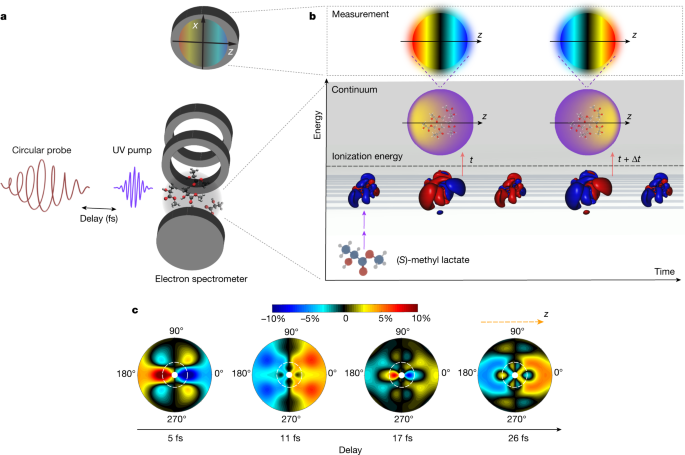Ultrafast Probing of Electron-Driven Chiral Dynamics in UV-Excited Neutral Molecules
Core Concepts
Attosecond time-resolved photoelectron circular dichroism reveals coherent electronic beatings between Rydberg states that modulate the chiroptical response of neutral chiral molecules on the few-femtosecond timescale.
Abstract
The content discusses the use of attosecond time-resolved photoelectron circular dichroism (TR-PECD) to investigate the ultrafast electron-driven chiral dynamics in neutral chiral molecules excited by ultraviolet (UV) light.
Key highlights:
Chiral molecules exist in two non-superimposable mirror-image configurations ((R) and (S) enantiomers) with different physical and chemical properties.
Attosecond technology can probe and potentially control electron motion within molecules on the intrinsic electronic timescale, enabling influence over chiral interactions.
The authors used TR-PECD with 2.9 fs temporal resolution to map the coherent electronic motion initiated by UV excitation of neutral chiral molecules.
They found that electronic beatings between Rydberg states lead to periodic modulations of the chiroptical response on the few-femtosecond timescale, with a sign inversion in less than 10 fs.
Calculations validate these findings and confirm that the combination of the photoinduced chiral current with a circularly polarized probe pulse can realize an enantioselective filter of molecular orientations following photoionization.
The authors anticipate that this approach will enable further investigations of ultrafast electron dynamics in chiral systems and reveal a route towards enantioselective charge-directed reactivity.
Capturing electron-driven chiral dynamics in UV-excited molecules - Nature
Stats
The authors achieved an unprecedented temporal resolution of 2.9 fs in their time-resolved photoelectron circular dichroism (TR-PECD) measurements.
The electronic beatings between Rydberg states led to a sign inversion of the chiroptical response in less than 10 fs.
Quotes
"Attosecond technology might enable influence over such interactions, given that it can probe and even direct electron motion within molecules on the intrinsic electronic timescale6 and thereby control reactivity7,8,9."
"We find that electronic beatings between Rydberg states lead to periodic modulations of the chiroptical response on the few-femtosecond timescale, showing a sign inversion in less than 10 fs."
Key Insights Distilled From
by Vincent Wani... at www.nature.com 05-22-2024
https://www.nature.com/articles/s41586-024-07415-y
Deeper Inquiries
How can the insights from this study be leveraged to develop enantioselective photocatalytic processes for the synthesis of chiral compounds?
The insights gained from this study, particularly through time-resolved photoelectron circular dichroism (TR-PECD) with high temporal resolution, offer a pathway towards developing enantioselective photocatalytic processes for chiral compound synthesis. By understanding the coherent electronic motion initiated by ultraviolet (UV) excitation of neutral chiral molecules and the electronic beatings between Rydberg states that lead to periodic modulations of the chiroptical response on a few-femtosecond timescale, researchers can design tailored photocatalytic systems. This knowledge can be utilized to control and manipulate electron-driven chiral dynamics in molecules, enabling the selective production of specific enantiomers in chemical reactions. By combining the photoinduced chiral current with a circularly polarized probe pulse, an enantioselective filter of molecular orientations following photoionization can be achieved, paving the way for the development of efficient and selective enantioselective photocatalytic processes for chiral compound synthesis.
What are the potential limitations or challenges in using TR-PECD to study ultrafast chiral dynamics in more complex molecular systems?
While TR-PECD offers unprecedented temporal resolution and the ability to map coherent electronic motion in neutral chiral molecules, there are potential limitations and challenges when studying ultrafast chiral dynamics in more complex molecular systems. One limitation is the complexity of the molecular systems themselves, which may involve multiple interacting chiral centers or intricate structural features. This complexity can make it challenging to interpret the TR-PECD signals and extract meaningful information about the electron dynamics. Additionally, the experimental setup required for TR-PECD, including the generation of ultrashort, non-ionizing, and perturbative light pulses, can be technically demanding and may not be readily applicable to all molecular systems. Moreover, the interpretation of TR-PECD data in complex systems may require sophisticated theoretical models and computational simulations, adding another layer of complexity to the analysis. Overall, while TR-PECD is a powerful tool for studying ultrafast chiral dynamics, its application to more complex molecular systems may pose challenges in data interpretation and experimental implementation.
What other spectroscopic techniques, in combination with attosecond pulses, could provide complementary information about the electron dynamics in chiral molecules and their implications for enantioselective reactivity?
In combination with attosecond pulses, several other spectroscopic techniques can provide complementary information about electron dynamics in chiral molecules and their implications for enantioselective reactivity. One such technique is time-resolved circular dichroism spectroscopy, which can offer insights into the chiral optical properties of molecules and their changes over ultrafast timescales. Additionally, time-resolved photoelectron spectroscopy can provide detailed information about the electronic structure and dynamics of molecules following photoexcitation. Pump-probe spectroscopy, when combined with attosecond pulses, allows for the investigation of electronic and structural changes in molecules with high temporal resolution. Furthermore, nonlinear optical spectroscopies such as two-photon circular dichroism spectroscopy can reveal additional information about chiral molecular systems by probing higher-order electronic transitions. By integrating these spectroscopic techniques with attosecond pulses, researchers can gain a comprehensive understanding of electron dynamics in chiral molecules and their role in enantioselective reactivity, facilitating the development of novel strategies for controlling chiral processes in chemistry.
0
